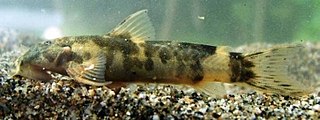
Joseph Nelson Rose was an American botanist. He was born in Union County, Indiana. His father died serving during the Civil War when Joseph Rose was a young boy. He later graduated from high school in Liberty, Indiana.
The pink corydoras is a tropical freshwater fish belonging to the subfamily Corydoradinae of the family Callichthyidae. It originates in inland waters in South America, and is found in the Meta River basin in Colombia.

The largemouth triplefin, Ucla xenogrammus, is a fish of the family Tripterygiidae and only member of the genus Ucla, found in the Pacific Ocean from Viet Nam, the Philippines, Palau and the Caroline Islands to Papua New Guinea, Australia, and the Solomon Islands, Fiji, Tonga, east to American Samoa and Rapa Iti, at depths of between 2 and 41 metres. Its length is up to about 47 millimetres (1.9 in). The generic name was coined by ichthyologist Richard Heinrich Rosenblatt in his unpublished dissertation of 1959 from the University of California Los Angeles and its is the initials of that institution, it was formally applied by Holleman in 1993.

Astroblepus is a genus of fish in the family Astroblepidae found in South America and Panama. This genus is the only member of its family. These catfishes are primarily found in torrential streams in the Andean area. Astroblepus pholeter and A. riberae are troglobites adapted to living in subterranean water systems. These species are typically small, less than 10 cm (4 in). The largest species reaches 30 cm (1 ft). These fish have suckermouths like those of loricariids. They have two pairs of barbels, maxillary and nasal. The dorsal fin spine lacks a locking mechanism. These fish also have odontodes, tiny teeth on their skin. All species exhibit a conical, pointy type on their fin rays like that found in other loricarioids; other species also exhibit a blunt type that is only found on their skin.

Labrisomus philippii, the Chalapo clinid, is a species of labrisomid blenny native to the Pacific coast of South America from Peru to Chile. This species can reach a length of 35 centimetres (14 in) TL and the greatest recorded weight for a specimen of this fish was 635 grams (22.4 oz). The identity of the person honoured by Steindachner in the specific name of this fish is unknown but it is thought to be one of the Chilean family of naturalists, the Philippis, Rodolfo Amando Philippi (1808-1904), the German-Chilean paleontologist and zoologist, his brother Bernhard Eunom Philippi (1811-1852) or Rudolfo's son, Federico Philippi (1838-1910).
Richard Heinrich Rosenblatt was an American ichthyologogist. Rosenblatt was born in Kansas City, Missouri in 1930, and died in San Diego, California in 2014. Rosenblatt was awarded the Frederick H. Stoye Award for undergraduate students in ichthyology by the American Society of Ichthyologists and Herpetologists in 1956 and 1957. He held three degrees from the University of California, Los Angeles, receiving his BA in 1953, his MA in 1954, and his PhD in 1959. Rosenblatt proposed in his unpublished dissertation what is now the genus name for the Largemouth triplefin, Ucla, after the initials of the University of California, Los Angeles (UCLA).

Astroblepus chapmani is a species of catfish of the family Astroblepidae. It can be found in the Magdalena River in Colombia.
Astroblepus eigenmanni is a species of catfish of the family Astroblepidae. It can be found on Ecuador.
Astroblepus festae is a species of catfish of the family Astroblepidae. It can be found on south Ecuador.

Astroblepus grixalvii is a species of catfish of the family Astroblepidae. It can be found in Colombia and Ecuador.

Astroblepus guentheri is a carnivorous species of catfish of the family Astroblepidae. It can be found in rainforest streams in the basin of the Magdalena-Cauca rivers and in some Pacific slope rivers in Colombia. It is an uncommon and not well studied species.
Astroblepus mancoi is a species of catfish of the family Astroblepidae. It can be found on the Ucayali River on Peru.
Astroblepus mariae is a species of catfish of the family Astroblepidae. It can be found on the Meta River in Colombia and Venezuela.
Astroblepus nicefori is a species of catfish of the family Astroblepidae. It can be found of the Cauca River and the Magdalena River in Colombia.
Astroblepus phelpsi is a species of catfish of the family Astroblepidae. It can be found on Lake Maracaibo in Venezuela.
Astroblepus regani is a species of catfish of the family Astroblepidae. It can be found in Ecuador.
Astroblepus rengifoi is a species of catfish of the family Astroblepidae. It can be found on the Atrato River in Colombia.
Astroblepus riberae is a species of catfish of the family Astroblepidae. This cavefish is endemic to the Cajamarca region in Peru.
Astroblepus rosei is a species of catfish of the family Astroblepidae. It can be found on Cajamarca, Peru.

Corydoras agassizii is a species of catfish found in the Amazon basin. It can be found in the border area of Peru and Brazil. It lives in tropical waters with a water temperature of 22 - 26 °C, a pH of 6.0 - 8.0 and a hardness of 2 - 25 dH.







